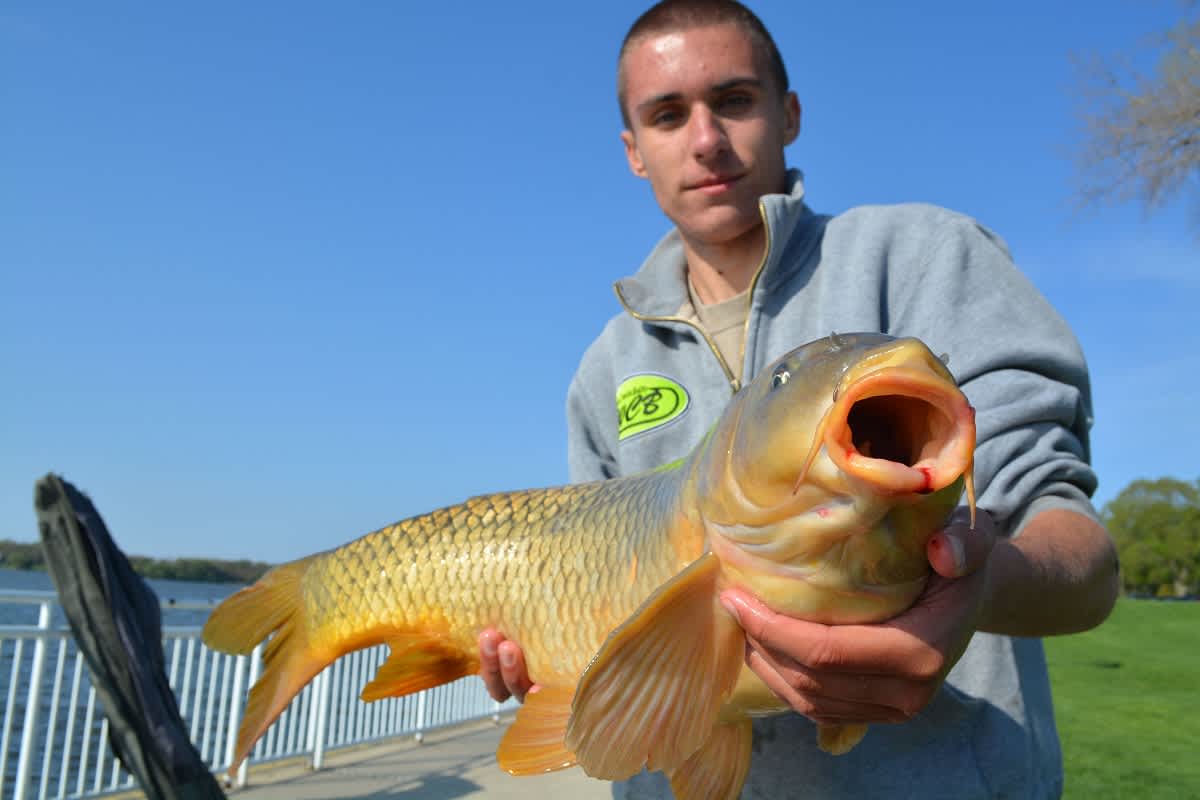Carping for a Wooden Shoe
Dave Mull 06.16.14

“It has happened to most everybody who ever fished,” the bricklayer from Greencastle, Indiana waxed philosophically with his downstate Hoosier twang. “They get a fish on and it takes drag, really puts up the best fight they’ve ever experienced and they’re all excited thinking they have a huge bass or something and then they see it’s a carp and they’re disappointed and maybe a little mad.
“We enjoy catching carp,” he said, nodding in the direction of 16 other members of the Carp Anglers Group (CAG) spanning the Kollen Park seawall on Holland, Michigan’s Lake Macatawa, their long rods sticking over the railing.
The mason’s name is Jathan Imhausen, and he’s 38 years old, married, and a lifelong shore angler. For eight years he has focused on—and invested in—carp angling. His days of propping a rod in a forked stick are long gone. How’d Jathan catch “carp fever?”

“This is what did it for me,” he said, pulling the line on a long spinning rod, which pulled the cord of the bite alarm and made the gadget, about the size of a lady’s wristwatch, emit a high-pitched electronic squeal. “A guy at a sports show showed me this and I was hooked.” He said he’s probably spent more than $6,000 on carp gear (“Don’t tell my wife!”), all of it for fishing from shore. His “pod” is an infinitely-adjustable rod holder setup; spinning reels are “baitrunners” that let a fish run with bait under controlled tension. The baits are perfectly round balls called “boilies,” or real corn kernels painstakingly cooked to the right scent and consistency. That day, Jathan’s most effective boilies were spicy.
Like the others, Jathan fished his boilies on “hair rigs,” snelled hooks with a bit of line hanging below the hook bend. The carper threads the bait onto this thread, which allows the fish to suck the bait into its throat, but only get hooked in the rubbery lip. These folks respect carp, some might say love them, and all of the fish are gently released.
The anglers had gathered for the fishing equivalent of an international soccer “friendly,” competing in a two-day event for which the winners get a wooden shoe (this is, after all, Holland). Entrants paid $30 to fish, and all the money went to Benefit4Kids, a non-profit organization that grants outdoor wishes to children with life-threatening illnesses.
Lake Macatawa, connected to Lake Michigan, is one of several “sunken river lakes” in Western Michigan that are fertile fish factories. Macatawa and the others feature wonderful fishing for more traditional gamefish such as bass, pike, and walleye. Their dense food chains also attract carp, and really big ones, especially in the early summer. A few of the anglers I chatted with from other states mentioned the appeal of coming to Holland was the chance to catch a “personal best”—the biggest carp of their lives.
I had come upon the group on Saturday, May 17, the first competition day, and it was now about 5 p.m. They had lines in 10 hours ago at 7 a.m., and had one more hour to fish.
Along the seawall are little orange flags at the end of thin wires, the type electric companies stick in the ground to mark buried cables. The section—about 75 feet by my guestimate—between the flags is referred to as a “peg.” At 6 a.m., each contestant had drawn to see what order they would be able to select their peg, the small bit of seawall that would be theirs to fish from all day.
Of the guys and gals I talked to, Jathan was having the best day, landing around 10 carp and a bunch of channel catfish that he’d given to an angler not in the carp contest.

“If I’d have brought my cooler, I’d have the makings of a really nice fish fry,” Jathan said, no hint of bragging in his tone. “I gave probably 100 pounds of catfish to that fellow. This is a really great fishing lake.”
Brian Pearcy of Belleville, in his first year of carp fishing, said he hadn’t caught a fish yet and was using mainly hand-me-down gear.
“The deal was, CAG members gave me the stuff to get started, but said if I started buying my own, I had to hand it down to someone else just getting started in the sport,” Pearcy said.
Brian Sherwood, originally from Houston, now living in Traverse City, Michigan, hadn’t caught a lot of fish, but had achieved a longtime goal of catching his first “mirror” carp: a genetically distinct variant of the common carp, its name reflecting its few, large scales that look like mirrors. It weighed 16 pounds, two ounces.
Darren Calver from Evanston, Illinois ended up taking one of the wooden shoes for biggest fish, catching a 27-pound, five-ounce common carp around noon the first day. Austin Pass, a 17-year-old from Allen Park, Michigan, took top-weight honors and the other wooden shoe with 188.04 pounds of carp from a total of eight fish, with one carp’s weight doubled.
I guess you could say it’s an odd sort of sporting competition with at least one odd rule.
Be that as it may, it was the friendliest of friendly competitions. It wasn’t hard to see the charm of carp fishing: hard-fighting fish, no need for a boat, and a great bunch of people.
The Carp Anglers Group costs $35 to join, check out www.carpanglersgroup.com to learn more.
For more information on Michigan fishing go to michigan.org. Click here to purchase a Michigan fishing license online.
This article was produced in partnership with Pure Michigan.

